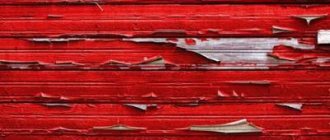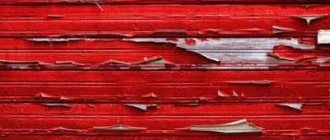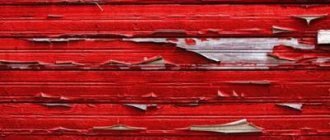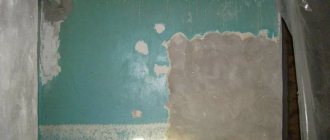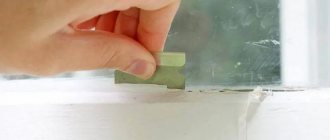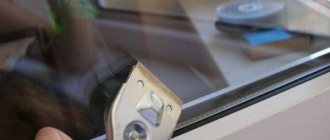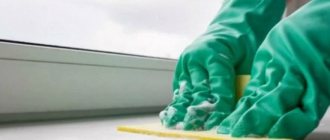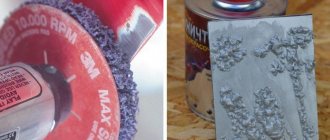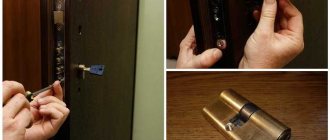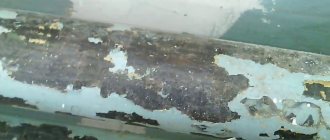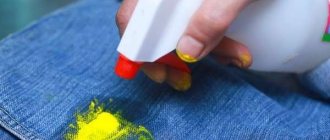How to remove oil paint?
To remove such a coating from a metal sheet, you must follow the following technological sequence:
- 1.5 kg of quicklime is diluted in water until a creamy mass is obtained.
- Cover the door with it and leave for 12 hours.
- the old layer is washed off.
Bleached lime
To remove the oil coating from a wooden panel, you need to moisten the surface with water and sprinkle with soda ash. Cover the door with damp burlap. It should not dry out, so it needs to be watered every hour. The next day the layer can be easily removed.
As mentioned above, you can clean the surface from the coating in different ways. It all depends on the conditions and possibilities. It is difficult to advise anything specific, because each owner has his own approach to this issue.
A comparison of the effectiveness of removal using a hairdryer and a special remover is shown in the video presented.
Cleaning iron doors
https://youtube.com/watch?v=jK6M7gvwg5c
Entrance doors are usually metal. They are constantly exposed to atmospheric conditions. Therefore, they cannot simply be painted over like wooden ones. The paint layer is completely removed from them. For cleaning you will need:
- acetone or white spirit;
- sandpaper of different grain sizes;
- Sander;
- putty knife.
Before work, the metal sheet is removed from its hinges and laid in a horizontal position. Remove colored layers using a sanding machine, using different attachments depending on the thickness of the previous layer. The small remaining layer is then coated with solvent and left to swell. The swollen paint is removed with a spatula. Just like on a wooden surface, the paint coating on a metal door is removed by thermal and chemical means. When using chemical removers, the product is immediately removed from the surface after removing the paint, cleaning the door with solvent and water. The cleaned surface is leveled, freed from cracks and flaws, using automotive putty in places of damage, then sanded by hand or with a grinding machine.
Bringing an old door back to life
The easiest option, but most expensive, would be to replace the old shabby wooden door leaf with a new one made of MDF, hollow inside. A thrifty owner will not throw away the old door, but will begin to restore it if:
- it is made of oak or other dense material that will last for several decades;
- has dimensions that differ from those accepted by the standard, especially in Stalin buildings with high ceilings. Making such a canvas to order will cost the owner a pretty penny;
- has an unusual decoration with carvings;
- The owners are creative people who can turn an ordinary wooden door into an art object.
Removing paint from a door
The procedure for bringing an old wooden product into proper form is conventionally divided into several stages:
- removing the old layer;
- repairing the door, preparing its leaf for new painting;
- fresh paint.
In order for the product to get a new life, to serve its owners for the intended time, and to avoid swelling and peeling, it is necessary to remove the old paint from the doors. Among the various methods, there are several main ones:
- thermal;
- mechanical;
- chemical.
Heat treatment
Heat treatment is carried out by directing hot air at the door. Such purification occurs when using gas burners and construction hair dryers. The advantage of this method of removing old paint from a wooden door is the absence of dust, but the disadvantage is the high probability of fire on the surface being cleaned. Such procedures are carried out outdoors, with the use of personal protective equipment (respirators, masks), and have a tank of water on hand in order to eliminate the possible occurrence of a fire in the bud. It is used in cases where there are several layers of coating on a wooden surface. Under the influence of hot air, the previously applied coating swells; it is scraped off with a spatula.
Mechanical cleaning
You can remove paint from the door using scrapers, spatulas, and metal brushes. The door is removed from its hinges, laid in a horizontal position, and the paint is removed using improvised materials and a sanding machine. The method is not effective due to dust and possible damage to the wooden surface.
Chemical cleaning
Characterized by obtaining a positive result, it is in greatest demand due to the speed of action of stripping reagents, which, when applied to an old paint layer, soften it, thereby facilitating the removal of old paint.
Attention!
Work is carried out in the open air or with a constant supply of fresh air due to the specific smell of cleaning agents.
Tools for work
The following tools are used to heat the painted surface:
- heat gun (melts the paint - easier to remove with a knife or brush);
- hair dryer (construction) - used for wood, can be used indoors, temperature is adjustable;
- gas burner;
- blowtorch;
- iron with foil.
The mechanical cleaning method, in addition to sandpaper, spatula, knife, and metal brush, involves the use of the following power tools:
- grinder equipped with a grinding attachment;
- Sander;
- drill with a brush for metal.
For chemical cleaning, you will need a spatula.
Having figured out how to effectively remove paint from a wooden door, you can begin the processing process. These methods will help you save on purchasing a new structure and improve the old one.
Features of cleaning a metal door
Removers and reagents allow you to remove cracked enamel, oil, acrylic, epoxy paint not only from wooden surfaces, but also to clean metal doors from various materials. The structure must first be removed from its hinges, the decorative trims and fittings must be unscrewed, and the glass inserts must be removed. It is better to treat the product with reagents in air. To make the paint come off without using force, heat it with a hair dryer, lubricate it with kerosene, and only then remove it with a spatula and sand it with sandpaper.
A sanding machine works well on cracked old layers. A nozzle with a medium coating is installed on the tool. When using a construction hair dryer, which melts the coating under the influence of hot air, you need to ensure that the metal does not overheat. When bubbles form on the material, clean it with a spatula. A heat gun or blowtorch quickly melts the paint, and the remaining substance is removed with a wire brush. Cracks or chips formed after removing the old coating are repaired with putty.
Metal doors are cleaned using any of three methods; with the mechanical method, the product is sometimes damaged; the thermal version poses a danger to human health. The use of removers and solvents allows you to quickly remove the coating without much effort.
How to clean and remove grease stains from interior doors using a cleaning product
It is surprising that interior doors made of various materials can be wiped off from grease using home remedies without damaging the coating.
What and on what doors can I use?
- Regular raw potatoes will remove stains from an MDF door. Lubricate the desired areas with a cut of a raw vegetable and wait until the surface dries, and then wipe with a dry soft cloth. The method is successfully used for old stains. If something happens, stains on the door can be removed with talcum powder or baby powder.
- Fresh grease stains can be removed using a solution of dish soap and a soft sponge. Afterwards, the door is washed with plain water and wiped dry. If the surface is glossy, it is advisable to treat it with polish.
- A viscous paste of clay and vinegar will help remove stains from an unpainted wooden door. The paste is applied to a greasy surface and waits until it dries, then removed. It is better to use kaolin clay to avoid leaving other stains.
- For a laminated door, grease solvents such as vinegar, ammonia, and acetone are suitable. The solvent is applied to the cotton wool and the surface is wiped. Before using it extensively, do a test on the bottom of the door to ensure that the laminate will not be damaged.
- Glass cleaning liquids are also used to clean doors.
- An interesting option is to remove dirt with a melamine sponge. Before work, it is moistened, it foams, and it is due to such adhesive foam that contaminants are removed. But you should not use it on varnished surfaces.
Thermal
A construction hair dryer is an indispensable tool for heat treatment of doors covered with old paint. Modern hair dryers have a heating regulator, with which you can soften the paint coating on a wooden surface, and then clean it with a knife, as shown in the photo.
If the door has glass, it is better to remove them. The temperature of the air that comes from the hair dryer is 600 degrees and the glass can simply crack.
If you are going to paint the restored canvas again with your own hands, it will not cost you much effort. We can only recommend that trial work be carried out first from the “wrong” side of the door. Then on the other hand you will not make possible mistakes.
Let's sum it up
Wooden doors are considered the most durable, and after restoration you can avoid painting them for five years. Interior doors will last even longer, as they are installed indoors and are not exposed to various weather influences.
Cleaning methods
There are several ways. Let's look at them in order.
Thermal method
It is usually used in cases where there are only a few cracks and the paint is holding firmly.
To start cleaning it, you will have to get an industrial hair dryer in advance. When heated, the material being cleaned begins to bubble.
The technology of the thermal method is simple, but this method is not suitable in all cases. This method can only clean the old layer if the base is wood. Plastic may begin to deform when heated.
Another disadvantage of the thermal method is the release of toxic fumes. Therefore, it is recommended to do this outdoors. As a last resort, you need to open the windows and put on a respirator.
Thermal methodMechanical method
Many people know about this cleaning method. You will need:
- spatulas;
- Bulgarian;
- wire brush;
- surface grinder.
Unfortunately, sandpaper on a machine quickly deteriorates. Therefore, it is rarely used to remove old coating over large areas.
First it is processed with a grinder. The paint is then cleaned with a wire brush. Residues are cleaned off with spatulas. This technology is labor intensive. Without the use of physical force, it will not be possible to clean the old coating.
Mechanical method
Chemical method
To remove paint, you can use chemical solutions; they will make the layers softer, and they will be easily washed off. For this use:
- solvents;
- acids;
- alkalis;
- special mixtures.
The solvent is applied to the door. Then you need to wait until the coating becomes softer. If the door is painted in several layers, you may have to use the solvent several times.
The peeled layers are cleaned off with a spatula. Sometimes they dissolve completely, all that remains is to rinse everything.
Removing paint
Chemical method
Chemical removers, which are sold in hardware stores, will help you remove the old layer of paint quite quickly and easily. Only they, of course, do not wash off the paint, but rather soften it, so you still have to work with a spatula. Typically, such a product is applied to the product with a brush or roller, left depending on the type of product and instructions - usually for 20-40 minutes, and then the softened layer is lifted and scraped off with a spatula. If the first time it was possible to get rid of only part of the paint, then the procedure is repeated, but the smallest remnants can be cleaned with sandpaper.
It is important, when buying such a remover, to check with the seller or see for yourself that it is suitable for your type of material and paint. You can save yourself the trouble of searching for a special remover for your type of paint by purchasing a universal product. Also think in advance about whether you can leave the room while the wash is in effect and then ventilate it well or take the product outside. If yes, then you can use a regular solvent-based paint remover; if not, then it is better to give preference to more modern, expensive odorless gel removers. But the absence of odor does not mean that they are not toxic: with any remover you must work with gloves, and the room must be ventilated.
Related article: How to replace the lock cylinder of the front door
From the experience of builders, we can say that cheap Russian-made removers do not cope well with old oil paint if it is applied in several layers. This problem does not arise with more expensive foreign analogues.
If you have caustic soda, then you don’t have to spend money on special washes at all: add a little water to it, dissolve the soda, and then mix with ground oatmeal to get a paste. Apply the paste to the product, wait about an hour until bubbles form, remove the paint with a spatula, and then degrease the surface. Gloves and ventilation are also relevant for this method.
Do not use plastic containers and tools when working with the remover, as they may deteriorate from exposure to chemicals. Also, you should not use removers if there is a plastic product located close to a wooden product.
Use of chemistry
The composition is used as follows:
- Open all doors and windows. Air must constantly flow into the room.
- All surfaces not to be treated are covered with plastic film. If liquid gets on furniture or the floor, it will cause stains.
- Pour the product into a separate container. Dip a brush or roller into the composition. The tool is selected taking into account the consistency of the wash. The roller is rolled over a perforated tray.
- Apply the solvent to the base to be treated. Wait until the coloring composition dissolves. The procedure takes 10-30 minutes.
- Remove the dissolved material with a metal tool. If necessary, the liquid is reapplied.
When choosing a wash, consider the following points:
- Gel formulations are more expensive than liquid formulations. However, the thick consistency provides faster results.
- When working in a room with poor ventilation, use the least aggressive compounds. Working with them takes a lot of time, but the possibility of poisoning is eliminated.
- It is not recommended to use inexpensive domestically produced solvents. A multi-layer oil coating cannot be removed with such a remover. Foreign-made equipment copes with the task faster.
- Some washes contribute to the darkening of the treated base. If it is impossible to refuse their use, the wood is bleached with chlorine.
You can remove old paint with caustic soda. The substance is dissolved in a small amount of water to the consistency of thick sour cream. Ground oatmeal is added to the mixture. The resulting paste is spread over the surface. When the paint swells, it is cleaned off with a spatula. Before further processing, the base is degreased.
Types of washes
Paint is best removed with special compounds that react with it. The canvas softens, but neither universal nor specialized removers have any effect on the structure of the wood. The first products are suitable for removing various materials based on water or solvent. Special removers are available for cleaning certain varnishes and paints. They contain substances that affect the structure of a particular coating.
Powder
Paint and varnish removers are available in different forms. The consistency of the washes is liquid, which cleans surfaces decorated with carvings well. Varnishes cope with several layers of cracked old material. Dry wash is more effective, suitable for cleaning large areas, and applies evenly when water is added.
Paste
In order not to dilute the powder with liquid to obtain the desired consistency, you can purchase a ready-made product in the form of a paste at a hardware store. The work is carried out in stages:
- The composition is applied to the surface with a regular brush.
- The door is wrapped in plastic wrap for 3 or 4 hours.
- The paint is removed with a sharpened spatula without pressing the tool.
- Water is combined with vinegar in a ratio of 5 to 1 and the remaining paste is removed.
The entire coating is not always removed at one time; in this case, the surface is sanded with sandpaper.
Using a remover, remove 8-10 layers of varnish or paint. You can make your own paste from caustic soda. The product is dissolved in water, oatmeal is added.
Gel
To remove paint, it is convenient to apply products with a jelly-like consistency to horizontal and vertical surfaces of different thicknesses. One of the inexpensive but effective Prestige gels does not require mixing or shaking before use. The remover is applied to the paint in a layer of 3 mm. After 3-5 minutes, the material is cleaned off with a spatula.
Syntilor Light gel removes polyurethane, acrylic, epoxy coatings, acts very quickly, and washes off enamel and water-based paint from wooden surfaces. The product penetrates into the deep layers of varnish, softening them. There are no acids in the gel; the composition is applied using a roller or brush in a layer of 1 mm.
Special fluids
To remove paint on wooden surfaces that have many small parts or carvings, it is recommended to use liquid reagents instead of paste or powder removers.
Before applying the composition to the door, wipe off dust and dirt, cover the metal parts and begin cleaning:
- The reagent is collected onto a brush and distributed over the surface.
- The canvas is wrapped in polyethylene and left for the time specified in the instructions for the liquid.
- Pry off the paint with a spatula and carefully remove it.
When using washes, safety precautions cannot be ignored, since they contain reactive substances. After removing the old coating, the wood is wiped with water and vinegar, primed, varnished, and painted.
How to clean a door from water emulsion?
How can I wash water emulsion? Today there are many products on the market that help remove various coatings from the surface. To deal with this material, you can use the most popular means.
"Estate" wash
Produced by Russian manufacturers. Suitable for working with different surfaces:
- tree;
- concrete;
- metal.
The remover does not contain harmful aggressive substances, therefore it is completely harmless to wood. Since the structure is gel-like, it is easy to treat the surface. When it dries, the coating begins to delaminate.
Working method:
- apply the composition with a brush to the surface of the canvas;
- wait 20 minutes;
- use a spatula to clean the loose layer;
- Rinse the door with warm water.
Rinse products
"Set Boya Sokucu"
A special remover designed to work with water-based emulsion.
Application technology:
- Lubricate the surface with remover;
- wait 10 minutes;
- Clean the raised coating with a spatula;
- If it was not possible to wash everything off immediately, the procedure is repeated.
After removing the water-based emulsion with a washing solution, the surface is wiped with a nitrocellulose solvent and then washed with clean water.
Consumables
Rags for removing dust, polyethylene to protect furniture and other objects, tape - it’s difficult to immediately say why it might be needed, but it’s a fact that it’s useful for something.
There are various removers available for old paint. Try to determine the type of paint and varnish material and select the appropriate chemistry.
Let's get started
The work ahead is quite dirty, and in the process, no matter how the coating is removed, quite unpleasant odors appear. If you plan to work indoors, cover the room with protective film and check whether it is possible to ventilate the room.
Start the process of removing old paint by using a hair dryer. Most models have temperature control - you need to select it experimentally. Hair dryers are often equipped with additional attachments. Among them there is a scraper attachment that allows you not only to direct a stream of hot air, but also to simultaneously scrape off softened paint.
Where the coating cannot be removed with a hairdryer, use other methods.
When the coating is mostly removed, the surface of the door leaf is additionally sanded to remove remaining areas of the coating and scratches from the scraper.
Remove dust and inspect the surface. It may be necessary to fill out defects in some places. Before filling chips and gouges, inspect the door to decide whether to paint it with new paint, or if the wood is in good condition, maybe decide that varnishing it will give the product more charm.
https://youtube.com/watch?v=VXTTVKbeJsM
Now you know how to remove old paint from a door. The old coating has been removed and the intended finishing can begin.
Simultaneous use of three technologies
You can remove paint from a door decorated with small fragments or from another complex surface as follows:
- scrape off the swollen areas of the coating with a scraper;
- “walk” along the door with a drill with an attachment, not completely removing the coloring composition so as not to touch the wood;
- warm up square by square, simultaneously applying remover to the hot surface;
- wipe off dissolved material residues with a worn cloth;
- wipe with a cloth soaked in solvent;
- Sand the door with fine-grain sandpaper.
Delicate application of each method in the specified sequence will ensure gentle, non-traumatic removal of all layers of old paint to the tree.
When planning to paint structures made of natural wood, you should not neglect priming the surface. It not only provides reliable protection of natural material from dampness, mold and pests, but also facilitates the removal of outdated coatings for possible restoration in the future.
How to treat wood and metal surfaces
A wooden door requires meticulous care, as well as high-quality processing during its creation. These factors will help preserve the canvas from moisture, fungus, mold, small pests, and cracking.
Step-by-step processing of wooden canvas from scratch:
- Before starting processing, the door is sanded with fine sandpaper. To eliminate large defects, use a coarse abrasive. In difficult cases, the surface is puttied.
- After preparatory work, it is customary to impregnate the wood with abiotics, which are antifungal and anti-mold agents. They are applied like regular paint with a brush or roller. If the solution is well absorbed, then you can soak the door a second time a day later. The abiotic penetrates deep into the structure and protects the door for many years.
Note: you can putty the door after applying the abiotic.
- When the door is completely dry, it is re-treated with sandpaper.
- Before painting, the canvas is covered with a double layer of primer. Use either wood primer or drying oil. The layers are not applied one after another, you must wait until dry.
- When treating doors with a varnish composition, the coating of primer or drying oil is eliminated and replaced with stain. The number of layers of stain determines how dark the wood will be in the end. The varnish is applied in two layers. The first layer dries for at least 36 hours.
Metal is also a capricious material, and if you haven’t been interested in the condition of your door for a long time, then do it right now. The most common damage to metal is its corrosion, which has many manifestations. For example, corrosion by spots, pitting, through and subfilm, when the destruction of the metal occurs under the coating. How can you treat a surface from rust?
- Clean the surface using wire brushes. This method is suitable for small stains; for thick layers of rust, it is used initially as an auxiliary method. It is not effective, since the degree of cleaning is low and a lot of dust flies in the process.
- Processing with a grinding disc. Suitable for small damaged areas; the surface is processed efficiently if the disc is made of good material. Please note that the disc is erased during the process, and its use requires skill.
- Processing metal with a sandblasting gun. The bottom line is that jets of sand fly out under pressure onto a corrosive surface, which as a result peels off.
- They also use a combination of water and sand, and waterjet processing of metal. Corrosion and previous painting are completely susceptible to strong pressure.
There are also chemical cleaning methods. Chemicals are used for this. They can be washable or indelible. The disadvantage of washable substances is that their contact with water creates additional conditions for corrosion.
- Hydrochloric or sulfuric acid at 5% concentration works well with corrosive coatings. Acids are so strong that an inhibitor must be added to them to slow down the effect on the metal. Its role is played by methenamine, in an amount of 0.5 g per liter of solution. Neglecting the addition of an inhibitor will play a cruel joke - not only rust, but also metal will dissolve.
- Treat the metal with a 15-30% solution of orthophosphoric acid with the addition of butyl alcohol (4 ml per liter) or tartaric acid (15 ml per liter of solution).
- For heavily rusted surfaces, use Vaseline oil (100 ml) and lactic acid (50 g). The cleaned surface is wiped with Vaseline oil.
But removing rust from a door is not enough; this is only the first stage in processing. What's next?
- A thoroughly cleaned surface with pronounced defects is sealed with automotive putty, wait for it to dry, and then treat the door with an abrasive.
- The surface is covered with aerosol primer. After this, the first layer of paint is applied, after drying it, the smudges are sanded and covered with a second layer.
The main types used are nitro enamels and powder paints, which are characterized by their low price, durability, and variety of colors.
Varnish coating
Varnish is usually used to coat wooden doors.
All varnishes are divided into:
- Alkyd. They come with pigment or transparent (slightly yellow). They do not dissolve in water. With additives they usually harden quickly and become durable.
- Nitrovarnishes. They dry instantly and are solvent-based, so they are very toxic. It is convenient to apply to the surface with a spray gun.
- Polyurethane. They are durable and darken the wood, so the surface is primed before applying them.
- Acrylic. They have higher environmental properties, but are inferior in durability and water resistance to other compounds. Odorless, water-based.
It’s worth remembering: the more toxic and “fragrant” the varnish, the longer it will last. Hardeners also increase service life.
Door processing process:
- The preparatory stage involves removing the old layer of paint with a hair dryer or sandpaper. Old varnish is removed with sandpaper or a special remover. Next, the surface needs to be sanded; the size of the abrasive is selected depending on the unevenness.
- Using putty that matches the tone of the wood, all defects are eliminated.
- Afterwards, an anti-pest impregnation and primer are applied. Both compositions must have the same base, otherwise peeling will occur.
- You don’t need to use an additional primer if the varnish does not change the color of the wood.
- Next, the varnish is applied with quick and careful movements. Application technique - overlap. The coating is created in at least three layers. Each of them must dry thoroughly before applying the other. All imperfections are sanded off during the process.
Before varnishing the entire door leaf, do a test in an inconspicuous place to be sure of the result.
Why repair the door?
Before considering ways to remove paint from doors and choosing the most suitable option, let's think about why waste time and effort.
- Old wooden doors are of good quality. They are made of solid wood, very often oak was used as the material for manufacturing, even if the door is painted.
- Non-standard antique door panels. Old apartments often have antique doors, tall, double-leaf, paneled. You can’t buy these in a store, and making them to order will be expensive.
- The door is beautiful. If you are lucky - and you own a door leaf richly decorated with carvings, it would be blasphemy to throw it in the trash.
- Art object. If you are a creative person who can create a work of decorative and applied art with your own hands, then a wooden door is an excellent field for creativity.
From the points described above, it is clear that there are plenty of reasons for restoration and repair, and you may have your own.
Other methods for removing old paint
If none of the methods is suitable, you can use simpler options:
- Water-based coatings can be easily removed with boiling water and a brush. Pour boiling water over the surface several times and then scrub the decor with an iron brush.
- Oil-based paints soften quickly when exposed to turpentine. A thick layer will have to be processed several times, but you can do without chemical removers and long rubbing with a brush.
- The enamel snaps off after treatment with acetone, another solvent.
Safety precautions
Removing paint from the floor is not too difficult, but when carrying out this work, certain rules must be followed:
Use heating devices with extreme caution, avoiding burning and inhaling vapors generated during heating of varnish and paint, while wearing a respirator. In addition to the latter, when using any of the methods, it is necessary to use other personal protective equipment that will prevent damage from vapors and dust not only to the respiratory tract, but also to the skin of the hands, wearing rubber gloves and goggles for this, which will provide protection to the eyes. Be sure to follow the instructions for using chemical compounds and tools. Before treating the floor covering with the chosen method, you must first test it on a small and less noticeable area, since in some situations any of the methods may be ineffective or ineffective. If you follow all these recommendations, you will be able to avoid many negative consequences
If you follow all these recommendations, you will be able to avoid many negative consequences.
Painting the door
After the preparatory work, you can start painting:
- The paint should be applied along the grain.
- When painting, the brush should be half dry. If it is completely wet, the paint will not be distributed evenly, and if it is too dry, it will be difficult to coat the joints.
- To prevent an MDF door from streaking, you can paint it in several layers. The first layer is applied from top to bottom, the second from bottom to top, etc. Before painting a new layer, you need to make sure that the previous one is completely dry.
- Using paint you can imitate real wood. To do this, the first layer is painted yellow or gray. Next, the surface is covered with liquid soap, and dark paint of the desired shade is applied on top of it. All you have to do is rinse off the soap, and the pattern of real wood will remain on the door.
Read further:
What you need to paint the ceiling and walls without streaks
Removing stains from a plastic window sill
How to choose paint for a wooden floor
How to apply acrylic paint to wood surfaces
How to varnish wooden floors
Why remove paint?
Many people believe that it is not necessary to clean the old coating from door structures. Eliminating this step reduces the time allotted for painting. But this is wrong, and there are several reasons for this.
- The owner or restorer probably doesn’t remember what the doors were painted with before. In addition, no one can guarantee that old and new coloring matter (even of the same brand) will not enter into a dangerous reaction, and the result will be completely different from what we expected.
- It is problematic to paint a product with already applied swollen paint. Even the most expensive dyes cannot guarantee an ideal final result.
Therefore, before painting the doors, the old coating must be removed so as not to create problems in the future, and also to be sure that the result will be satisfactory.
Swollen paint will not allow you to paint the door well.
How to remove paint from a metal sheet?
A wooden door can be periodically tinted, but metal doors require a different approach. They are constantly exposed to atmospheric influences. To update them, you need to clear the old layer. To do this, use a grinder or a drill equipped with special attachments.
Before processing begins, the door is removed from its hinges and the fittings are dismantled. It is advisable to do the work outdoors. The coating can be removed using a variety of tools and means:
- kerosene;
- sandpaper;
- spatula;
- grinding machine.
Just don’t think that such work will not require any effort. Even when very strong chemicals are used, it takes some effort to remove paint.
You won't be able to clean it with just a spatula; you'll need a hard attachment or a good solvent. Using only one tool, you can scratch a smooth metal surface. This defect cannot subsequently be hidden even under a thick layer of paint.
The steel is processed with a grinding machine. Of course, you can do this with sandpaper, but the speed of such work leaves much to be desired.
A grinding machine can easily handle old layers, but only if the attachments are selected correctly. Usually the work is carried out with a medium spray head. The head rotation speed should be minimal. The work must be done carefully so as not to accidentally damage the door.
The right nozzle helps you get the job done quickly. The head needs to be constantly cleaned - it quickly becomes clogged with debris. The efficiency of the work depends on the cleanliness of the nozzle.
After any removal method, you must sand the surface to achieve smoothness. If cracks are found on the canvas, cover it with putty. Before you start applying paint, the surface is primed. When the soil has dried well, you can begin painting.
Cleaning
Features of removing paint from doors
Painting doors is an alternative way to restore their attractive appearance. If there are several door structures in the house, then during restoration it is advisable to give them a single (or at least similar) shade. But before you start painting the door leaf, it must be carefully prepared. And to do this you will need to clean the old paint from the surface. You will also need to prepare the old door for new painting and only then can you apply a new coat of paint to it.
Related article: How to lubricate the lock cylinder of the front door
Don’t be afraid of updating antique doors, because with the right approach to renovation they can become a decoration for any room. Remember the main rule - the paint coating should be applied evenly to the door leaf. This effect can be achieved only if the surface is properly prepared for the procedure, making its structure homogeneous. It is for this purpose that it is proposed to first remove the old paint from the wood.
Compliance with the following rules will help you complete the preparatory procedures correctly:
- First, try to thoroughly clean the door from old paint . There should be no traces of the old coating left on the surface of the canvas. If this requirement is not met, then in the future the old paint and varnish material will begin to swell, and the entire surface of the renewed door will be damaged. You will do all the preparatory work yourself, so focus on its quality.
- After removing the old coating, the canvas must be leveled, removing potholes and small cracks. For these purposes, there is a special material - putty. When buying it, pay attention to such characteristics of the material as frost resistance and moisture resistance, as well as information regarding at what temperature conditions the putty will retain its properties. There are varieties of material that do not tolerate excess moisture and negative temperatures. This should be taken into account when purchasing.
- A separate issue is the purchase of varnish or paint for a restored door structure. It is better to choose cans with such compositions with one serial number - then you can be sure that the paint will not differ in its shade.
There are several ways to remove old paint from a wooden surface. If the door was painted in one layer, and the paint composition still retains its attractiveness, then the surface is only lightly sanded and a new layer of paint is applied on top. However, this should only be done if there are no cracks or damage on the old coating. It is better, of course, to remove the old paint. This process is carried out in the following ways:
- Heat the surface and remove the old paint from the doors, because under the influence of heat it will become soft and pliable.
- Another good way to remove old paint is to scrape or sand the wood. This method is classified as mechanical. It is characterized by its labor intensity and duration, but demonstrates a high degree of efficiency.
- Old paint can also be removed using a chemical method. It involves the use of special reagents called washes.
Wax pencils and polish for bare wood and MDF
Scratches and other damage can be repaired on wooden surfaces with wax and polish. Polishes are substances that can add shine to the surface being treated. They are presented as paste-like mixtures or emulsions that have a long shelf life.
To remove a scratch in wood, sand the damaged area with a fine abrasive, then apply soft polishing wax and rub with a cloth. A soft wax pencil is used to treat deep scratches. Pencils have a wide color palette, which allows you to choose the desired tone. After repairing the damage, remove any remaining wax with a dry cloth. The surface is coated with varnish or paint to match the door.
When working with MDF profiles, wax pencils are simply irreplaceable when you need to cover the gap at the joints of the profile.
Pros of using wood correctors:
- Operational restoration
- Variety of color palette
- Versatility
- Durability due to increased material adhesion and water resistance.
Methods for removing paint from a door depending on the material
To decide how to remove old paint from a door at home, you need to determine the most appropriate cleaning method.
There are three types:
- chemical - use of chemicals;
- mechanical (instrumental);
- thermal - exposure to high temperature.
Sometimes, to carry out better work, it is necessary to combine two methods.
Chemical method
The chemical removal method is the most convenient and takes little time. This is a method without the use of special equipment or electricity. Suitable for removing heat-resistant coatings that cannot be heated.
To select the correct type of chemical, you need to know what material was previously used. A consultant from a construction supermarket will help you choose a special “wash.” Before using it, you must study the instructions and also use personal protective equipment. When working with toxic solvents, you will need a respirator - be sure to use gloves and safety glasses.
What solvents are used?
For convenience, “washes” are available in different forms. This allows them to be used on any surface:
- liquid reagents;
- pastes;
- jelly;
- dry mixtures for preparing solutions.
The following types of solvents are used to dissolve paint coatings:
- based on white spirit for dissolving oil, nitrocellulose, pentaphthalic paints and varnishes from wooden surfaces;
- products based on caustic soda or caustic alkali (dissolve acrylic and water-based paints).
Before treatment with the reagent, the surface should be cleaned of contamination. The substance is applied for about 30 minutes, then the softened layer is removed with an iron spatula. If necessary, the procedure is repeated until the painted layer is completely removed.
Mechanical method
Before deciding how best to mechanically remove old paint from a wooden door, you need to acquire the necessary equipment. Mechanical processing of MDF and fiberboard will require more effort than using a “wash”.
Dry layers can be removed manually: with sandpaper, a spatula, or a metal brush. A lot of time and effort is spent on such work. It’s easier to do this with the help of electric tools, which you can rent at a hardware store or from friends.
Using a knife with a spatula can easily remove paint in hard-to-reach places. Then, the canvas is processed with coarse sandpaper.
Precautionary measures
It is better to remove paint from the door leaf mechanically outdoors. When processing with tools, dust is generated, so it is recommended to clean the surface a little and moisten it with plain water. To avoid breathing dust, you need to stock up on a respirator or mask.
For mechanical cleaning, you can use a piece of glass. You must be very careful not to injure yourself or damage the wood surface (it is recommended to wear thick protective gloves). Unnecessary layers should be removed along the wood fibers.
Thermal method
The thermal method of removing old dye is based on heating the layers until they soften. Since high temperatures are used during operation, this method is not suitable for flammable materials such as plywood. When working with a wooden door, you need to choose the appropriate temperature regime.
Expensive fittings, decorations, and glass are removed before all work is carried out so that they do not melt or be damaged in any other way. The surface is cleaned of dirt, dust and debris. Remove the paint the moment it softens and bubbles.
Important! When using the heating method, you need to be careful not to get burned on the hot surface, especially if you are working on a metal door. Thermal heating is best carried out outdoors to avoid the appearance of a pungent chemical odor and toxic volatile substances
Thermal heating is best carried out outdoors to avoid the appearance of pungent chemical odors and toxic volatile substances.
How to avoid damaging the door covering?
Cleaning door panels of old coating will require effort, especially if several layers of paint and varnish materials have been applied. Having completed this time-consuming task, the result of applying a new coating will certainly please the owners - it will give the structure an updated look.
If you neglect this update stage, the result may be unpleasantly surprising. The new coating will lie unevenly and will repeat all the smudges and cracks. All paints and varnishes are composed of chemicals, so it is unknown what reaction to expect when two dyes interact in different products. Layers may bulge and the color may not be as expected.
Having decided to independently remove the old painted layer, you need to determine the most suitable method of carrying out the work. The choice of method directly depends on the material of the door leaf. Wood, plywood, compressed sawdust or metal require a different approach. The methods used to remove the painted layer from metal are not at all suitable for wood.
When starting work on removing paintwork, take into account the following parameters:
- canvas material;
- number of dry layers;
- type of paint and varnish materials used previously.
Considering all these points, it will be possible to determine with less effort the most suitable reagent or tool for removing the ink base. In addition to removing old paint from wooden doors, the surface is cleaned and cracks are sealed. Before carrying out any manipulations, it is advisable to remove the structure from its hinges.
Only after the preparatory work has been completed can you begin to apply new paint.
How to remove old paint from walls
The most difficult thing to remove is old oil paint from concrete walls. Paintwork can be removed with solvents, but this is not recommended in poorly ventilated areas.
You can remove paint from the walls using a hair dryer. The coating should be heated until it softens, and then removed with a spatula. The main disadvantage of this method is that fumes from varnishes and paints are harmful to health.
The mechanical removal method - using notches with an ax - is convenient for small surfaces. What else can you use to remove old paint? Many people use a hammer drill with a brick crown or a “paint remover” attachment.
How to remove paint using heat and abrasives?
Before repainting your piece, learn how to remove paint from wood using heat. This method is simpler than the previous one, but more dangerous, as it can cause a fire in the paintwork. The method is based on the fact that when exposed to temperature, the paint begins to decompose and release gas.
It penetrates and accumulates under the coating, causing the paint to bubble and completely separate from the wood base.
To thermally remove old paint from a wooden surface, take a hairdryer or iron that is used in construction. How to clean old water-based paint from a wall? A hair dryer works like a regular hair dryer, but has very high air heating temperatures.
In the second case: the foil is applied to the surface, heated from above with an iron, and then removed along with a layer of unnecessary paint.
The easiest way to remove old cracked paint is mechanically using:
- grinders or drills with grinding pads
- sandpaper of varying degrees of hardness (according to the size of the abrasive elements)
This creates a lot of dust, so make sure you have protective breathing masks and a gown to safely remove old paint from woodwork.
Alternative methods
If there is no proprietary wash composition, other preparations can be used. Below are some instructions for using various washes at home.
Caustic soda solution
You can use either regular caustic soda or a solution that, in addition to soda, includes oatmeal and water.
When using this chemical, do not forget about safety precautions (safety glasses, gloves)
Instructions for using caustic soda:
- We dilute baking soda in a container with water.
- Apply the solution with a wide brush. The remover must be distributed sequentially, without gaps on the surface.
- We wait until the soda saturates the wood. After a while, the soda will begin to corrode the paint, and the coating will become covered with bubbles.
- Remove the paint layer with a metal spatula. If there are pits in the surface, you can use a chisel, small spatula or a piece of sandpaper.
- We wash the wood first with a soap solution and then with a stream of warm water.
- Dry the material well before priming or painting it.
If the paint layer is thick or there are hard-to-reach areas on the surface, it is more effective to use a thick composition. You can achieve thickness by mixing baking soda with oatmeal in water. The waiting time after applying the solution to wood is approximately 1-2 hours.
Bleaching powder
Bleach can be used both as a stand-alone paint remover and as an addition to remover. In the latter case, bleach acts as a bleach. The fact is that after removing the paint, rotting or fungal damage will be revealed. In such cases, stains are inevitable, which bleach will help to whiten.
The paint is removed as follows:
- We dilute bleach in a container with water.
- Apply the chemical to the surface using a hard brush or steel wool.
- As the bleach evaporates, the wood will gradually dry out.
Note! Work with bleach only in conditions of good air circulation and using personal protective equipment.
Heat treatment
The essence of this process is to heat the wooden surface, due to which the varnish adheres less firmly to the surface. In other words, the varnish begins to crack, after which it can be pryed off with a tool (a chisel or spatula will do) and slowly removed.
Please pay attention to the following nuances:
- During work, you need to use protective equipment (gloves and goggles), and also ventilate the room. The fact is that when heated, the varnish releases toxic substances, and when the material is mechanically separated, pieces can bounce off of it. Also, do not forget about fire safety.
- If the varnish is heated up, but does not peel off, but becomes charred, you need to change the cleaning method and you cannot do without chemicals.
Required tools:
Gasoline or gas burner. Such devices are quite inexpensive
However, the burner must be used with extreme caution, as the work will be carried out with an open flame. Care must be taken when working with the burner
Construction hairdryer. The device is similar to a household hair dryer, but has significantly greater temperature capabilities, heating up to 600 degrees.
Note! A standard household hair dryer is not suitable for removing nail polish. The main advantage of the thermal method is its high speed of operation.
However, we must not forget about the danger of overheating the varnished surface, since in this case it may catch fire.
The main advantage of the thermal method is its high speed. However, we must not forget about the danger of overheating the varnished surface, since in this case it may catch fire.
The work is done with both hands: one holds the hairdryer, which heats the surface, and the second holds a spatula for removing nail polish.
